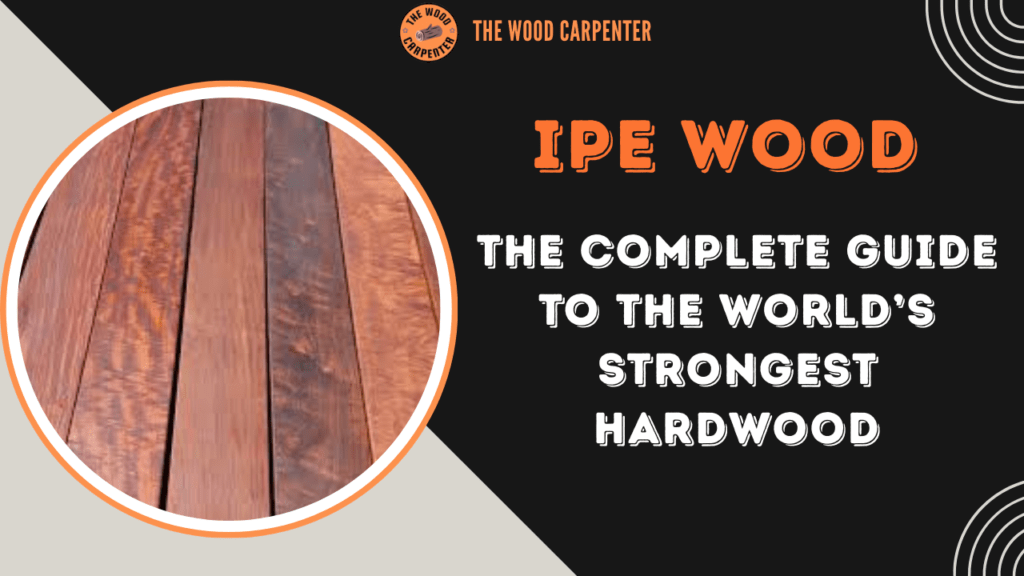
Ipe Wood: The Complete Guide to the World’s Strongest Hardwood
If you’re looking for top-quality decking and other outdoor materials, then chances are, Ipe wood, also referred to as Brazilian Walnut, is at the top of your list to check out for a high-end deck or pergola. From boardwalks to high-end outdoor furniture. Ipe, renowned for its density, durability, and beauty, around the world. We will take a close look at what Ipe wood is in this guide along with its cost, uses, pros and cons, and how to spot it, plus answers to the most frequently asked questions.
What Is Ipe Wood ?
Ipe is a tree from the Handroanthus genus (formerly called Tabebuia), which is native to South and Central America, especially Brazil. It is widely considered as one of the hardest and the most durable timber species in the world.
The density of Ipe wood is compared to steel means we can know that it is extremely strong and will serve a range of demanding applications.
Density: It is more than 1,000 kg/m³— dense enough to sink in water.
Hardness: Janka hardness around 3,500 lbf, considerably harder than oak and maple.
Life Span: It will come around 65-75+ years outdoors with little care.
Fire Rating: Class A — equivalent to concrete or steel.
This makes Ipe perfect for deck projects, boardwalks, fencing, railings, and other outdoor applications that require extreme durability and weather resistance.
Ipe Wood Price
Ipe is a stable and resistant hardwood and comes with a price tag that is commensurate with its rarity and hardiness:
Average Cost: It costs around $10 to $20 per square foot for decking board (depending on the grade, species and user preference)
Comparison: It is around 3 to 5 times the price of softwoods such as pine, and sometimes more than composites or cedar.
Long-term Value: Though the price tag tends to reflect negatively in the short term, Ipe actually lasts a lot longer, and is replaced less frequently, sometimes making it more cost-effective over many years.
What Kind of Wood Is Ipe ?
Ipe is a hardwood species from the tropical rainforest, and it is internationally rated as very durable. It is a member of the Handroanthus genus of flowering trees, which reach 40–45 m in height.
Key properties:
- Resistance of Rot and Pests: Resistant to fungi, insects, and termites.
- Dimensional Stability: Shrinks less than many of the hardwoods.
- Natural Oils: Preserve it from the weather and crumbling.
Ipe Wood Decking
Decking One of the most popular uses of Ipe is for decking. Indeed, it was famously applied to the Coney Island Boardwalk, where it withstood decades of heavy pedestrian use.
Advantages of Ipe Decking:
- Long lifespan (50–75 years outdoors).
- Extremely low maintenance.
- Resistant to extreme weather, and moisture and ultraviolet rays.
- Rich and luxurious appearance with reddish-brown to deep olive hues.
Maintenance Tips:
- Wash with gentle soap and water.
- Hardwood oil can also be applied once a year to keep color.
- Without treatment, Ipe will age to a silvery gray finish.
What Are the Disadvantages of Ipe?
Ipe has some disadvantages, though not many:
Expensive: Among the pricier materials for decking.
Workability: Difficult to work, with tearout being a common problem since it has interlocked grain.
Weight: Difficult to move and set up.
Environmental: Concerns of Overharvest Overharvesting has led to issues of sustainability. Always look for FSC-certified suppliers.
How to Identify Ipe Wood
Identifying Ipe can be tricky, but there are a few tell-tale signs:
Color: Reddish-brown to dark olive, sometimes with black streaks.
Weight: Offers more weight, typically, than any other wood; your board will be notably heavy to hold.
Texture: Fine to medium, naturally oily.
Scratch Test: Much tougher to scratch or scuff than softer woods.
Water Test: Ipe will sink in the water because it is a very dense wood.
Comparing Ipe Wood to Other Woods
| Feature | Ipe Wood | Teak Wood | Cedar Wood | Redwood |
|---|---|---|---|---|
| Hardness | High | Medium | Low | Medium |
| Durability | 50+ Years | 30-40 Years | 15-20 Years | 20-30 Years |
| Maintenance | Moderate | High | Low | Moderate |
| Price | Expensive | Very Expensive | Affordable | Expensive |
| Fire Resistance | High | Medium | Low | Medium |
| Resistance to Insects | Excellent | Good | Moderate | Good |
| Weather Resistance | High | High | Low | Medium |
FAQs About Ipe Wood
1. Is Ipe better than teak?
Both are among the best hardwoods, but Ipe is harder and denser and more fire resistant than teak. But teak is easier to work small, and it’s been used longer in the boatbuilding business. Ipe is often better for decking.
2. Is Ipe wood toxic to humans?
Ipe wood particles can bother the skin for some people and the eyes or lungs in others. Keep your lungs and skin safe by using gear when cutting and sanding.
3. Is Ipe waterproof?
No wood is completely waterproof; however, Ipe is exceptionally resistant to the effects of water. It’s density and natural oils make it resist swelling, warping, distortion, rot and decay.
4. Does Ipe turn grey?
Yes. If it is left untreated, actually this Ipe naturally weathers to a beautiful silver-gray patina. But applying UV-protective oil will preserve its original rich brown color.
5. Is Ipe a mahogany?
No, They have similar color and often mistaken with each other but they are 2 completely different species. Mahogany is in the Swietenia genus, where this Ipe is from Handroanthus.
Final Thoughts
Ipe wood is in a league of its own; super durable, fire-resistant and drop-dead gorgeous. Aside from the fact that it has a cost, another downside is its workability and now rare sustainable designation, but if you want something that lasts 75+ years, requires next-to-no maintenance & looks beautiful, then Ipe wood is worth every penny.

